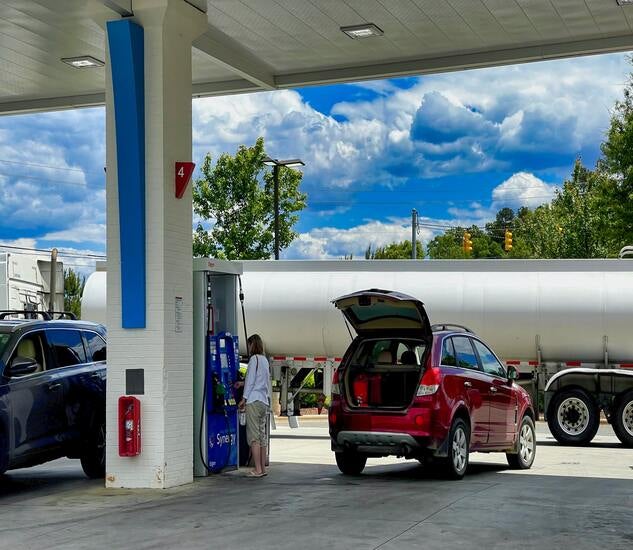
Carbon capture and storage (CCS) is a technology long considered a potential Hail Mary solution to carbon emissions, originally perceived as a means of maintaining the fossil fuel industry while preventing emissions from leaching into the air. However, genuine efforts to develop the technology never took off and the possibility was side-lined. The situation is starting to shift however and the technology could be one that genuinely helps nations curb emissions.
The rise in public as well as private investment also means that scaling up this solution is more viable now than ever before, with the UK Government announcing in November last year that it would be funding four CCS cluster projects over the course of the next 10 years.
How well do you really know your competitors?
Access the most comprehensive Company Profiles on the market, powered by GlobalData. Save hours of research. Gain competitive edge.

Thank you!
Your download email will arrive shortly
Not ready to buy yet? Download a free sample
We are confident about the unique quality of our Company Profiles. However, we want you to make the most beneficial decision for your business, so we offer a free sample that you can download by submitting the below form
By GlobalDataThe stage is seemingly set for the UK’s CCS industry to finally realise its potential. But what’s been standing in the way of this technology taking off? And could these challenges arise once more? We find out.
The potential of CCS
According to OGUK’s ‘Energy Transition Outlook’, rock formations under the North and East Irish Sea have the capacity to hold 78 billion tonnes of CO2, a figure roughly 190 times greater than the UK’s annual emissions. Not only would tapping into this resource help to curb oil and gas emissions, but it would offer a means of decarbonising other heavy industries such as cement and steel makers, chemical manufacturers, and power stations.
Such potential has led the industry body to identify it as a key technology in transitioning to a net-zero economy, and the report follows hot on the heels of the government’s latest Net Zero Strategy, which says that CCS, linked with mass production of low-carbon hydrogen, will be essential.
However, Will Webster, energy policy manager at OGUK, says that the technology has some way to go before it can begin to meet its potential, and investment into projects is crucial if this is to change.
“We don’t really have any CCS in the UK at the moment, apart from some very small pilot projects. And we’ve got to get from that situation, to one where we’re capturing 20-30 million tonnes of CO2 per annum – which is the new government target for 2030,” he says. “Then we have to reach 100 million tonnes by 2050 – which would represent a quarter of the UK’s CO2 emissions.”
Until other storage technologies are streamlined (such as nuclear fusion or battery storage), such carbon-cutting methods would, Webster says, be the fundamental means of maintaining lower emissions. While a lack of funding would previously have made this unlikely, a shift in government attitudes towards the sector is driving a change.
“Previous efforts to do CCS in the UK never got off the ground, and one of the reasons for that is it was seen as a purely private investment thing, and that’s a mindset that’s completely changed,” Webster says.
“We’ve now got a concept from the government that this is a national effort, and one that needs a bespoke framework to develop it. The idea is that the government gives a regulatory framework for the pipelines and storage, and will support private industry to develop those through kind of regulated charges.”
Even with government funding secured, the path to full scale CCS is not, of course, entirely smooth, and managing environmental concerns need to be considered before we can expect the change to be fully enacted.
The environmental question
Professor Stuart Haszeldine OBE, from the University of Edinburgh’s Scottish Carbon Capture and Storage Department, says that the UK has not yet managed “joined-up thinking” on how to manage offshore hydrocarbons.
“The International Energy Agency has made it very clear that no new hydrocarbon fields or coal mines should be developed, if the world is to remain within climate guardrails of 1.5°C, or even 2°C average warming,” he says. “The UK Oil and Gas Authority has been placed in an impossible position, with a mandate to produce maximum economic recovery of all oil and gas UK offshore, whilst simultaneously placing a climate review on any new developments.”
One solution that Haszeldine proposes is to implement a system of “producer responsibility”, where companies are held accountable for the impact of their products – from sourcing to consumption. Webster similarly says that environmental frameworks will need to be put in place to keep fears of misuse at bay.
“One of the things that’s going to have to happen is there will need to be environmental monitoring of CO2 pipelines and CO2 stores,” he says. “You’ll have to have remote monitoring, you have to have your IP verified, and then if you have an issue like a leak, you’re going to have to have some kind of process for how industries will have to pay for their emissions.”
Smoothing out such issues would, however, be the case for any nascent technology, and general perception seems to err towards thinking the benefits outweigh the problems.
An economic incentive
From an economic perspective, while the investment needed is high, the payoff would be significant, and establishing a CCS industry could also provide a steady stream of job opportunities.
“Costs of capture vary by facility, with pure CO2 streams costing £20-£50 per tonne, power plants £80, with transport and storage £5-£20/tonne,” says Haszeldine. “Economic models simulate this to be much cheaper than International Energy Agency modelling projections of carbon taxes of several hundreds, rising to several thousands of pounds per tonne, and much more reliable than the present system of allowing CO2 emissions to continue by purchase of emissions trading scheme certificates.”
When it comes to employment, many offshore specialists would be needed to develop underwater CCS, and there would be significant crossover. Not only does this mean much of the workforce is already in place, but the technology required to scale up is already known.
“You’ve got all of the subsurface skills,” says Webster. “Often for storage, they’ll be using depleted gas fields or saline aquifers; so there we can harness all of the expertise around geophysics and seismic data, making sure that the potential storage locations are secure and will keep the CO2 there indefinitely. You’ve also got pipeline management and CO2 handling – all things that the sector would be pretty familiar with.”
At a glance, it would seem that there’s nothing standing in the way of seeing CCS becoming a central part of the UK’s energy mix in the near future – with the skillset, workforce, and economic incentive already in hand. However, the road to industrial scaleup is long, and government support is needed to maintain momentum.
As Mike Tholen, OGUK’s sustainability director, writes in a statement: “This is a project that will take some years, but it is also one that will help secure our nation’s low-carbon future.”







